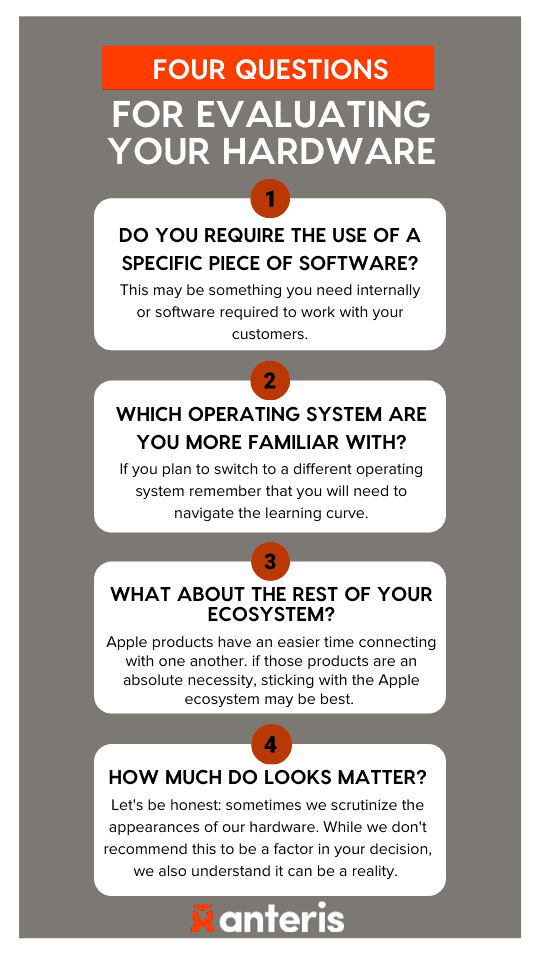Prospective and current Clients often ask us about the differences between Apple and Windows-based hardware. The quick answer: either platform can effectively address your needs. Both offer similar performance for a range of business scenarios.
However, depending on your exact needs, one platform may hold an advantage over the other. This article will highlight those differences and provide some key ideas to consider when making a hardware—and operating system—decision.
Why is the Conversation so Heated?
Brand loyalty has a lot to do with perceptions of superiority. Nine out of ten iPhone users plan to stick with Apple, while HP and Dell are the two most popular manufacturers of laptops, with Apple coming in third. Whether a Windows user or Mac user, consumers aggressively defend their favorite brand and will overlook quirks and inconveniences.
A mixed-use environment is possible. Our team at Anteris uses a combination of Apple and Windows machines. Popular apps and software effectively talk across platforms, which makes basic information exchange easy.
However, depending on your usage, fully integrating Apple and Windows hardware requires tools that can be pricey. Apple locks their products into the Apple ecosystem, so they require workarounds to solve that issue.
What Level of Hardware Do I Need?
Under most circumstances, we recommend business class hardware—computers and servers with higher processing power, memory, and features—if your business deals with complex operations.
Clients who engage in creative work, such as graphic design, advertising, or video editing, frequently use Apple hardware. Desktop Mac computers handle the bulk of processing and compiling, while MacBooks are suitable for less demanding tasks. One Client who operates in the creative space uses over 100 MacBooks in their business. MacBook Air models are the most common, but these machines have served for years and are becoming dated. In response, the Client is phasing them out for MacBook Pro models, with a boosted performance that should lead to longer shelf life.
Price is absolutely a factor here. In a business environment, Apple is going to be more expensive to purchase. MacBook Pros, for example, can be as high as $2600. A Lenovo (Windows) machine can be about $1700. You’ll save a bit of money going Windows.
However, as we mentioned above, you may have specific programs or features that are important for your business. If that is the case, focusing on a particular brand may be ideal.
Won’t My Hardware Go Out Of Date Quickly?
You should purchase hardware intending to recuperate your investment. We encourage businesses to purchase the level of hardware that allows them to respond best to the needs of customers. Underpowered hardware, which requires a lot of time for applications or has limited storage space, can cost you down the road with repairs and workarounds. Excessively powered hardware is nice but requires far longer to recuperate your investment.
Reliability is another concern for selecting hardware. As a brand, Apple products have a reputation for lasting longer, on average, than Windows-based machines. In our experience, much of this comes down to how users maintain their hardware.
Regular maintenance, keeping your system up to date, and protecting the hardware from liquid and damage are fundamental to maintaining any machine. In general, we recommend a hardware upgrade schedule based on warranty. Hardware needs to be under warranty so that should a problem arise in which we need parts for the repair, we are able to get them.
Out-of-warranty hardware may have limited availability of parts, making repairs and maintenance difficult or impossible. This upgrade schedule ensures our hardware keeps providing powerful performance while maintaining great value.
If your current machines are struggling to keep up or cause frequent problems (your technology is frustrating, not freeing), then it might be time for an upgrade.
Tips to Determine Your Needs
You may still be unsure which hardware to choose, and that’s okay! Here are some questions to consider:

Mac vs PC for Business
Your team can be productive whether you choose Apple or Windows products. The lack of definitive statements in this article might be confusing, but there’s very little that separates Apple and Windows systems. Significant differences come into play when selecting a level of hardware and your specific software needs.
We cannot emphasize enough the importance of selecting the right level of hardware for your needs. A team member who primarily works with basic productivity applications — think Microsoft Office products such as Word, PowerPoint, and Excel — won’t be able to take full advantage of top-line hardware. And a team member running multiple applications, working with large amounts of data, or requiring graphics to get their job done will struggle with basic levels of hardware.
Companies with varying levels of hardware are common and easy to work with.
How Anteris Can Help
It’s difficult to nail down what hardware will best serve your business. At Anteris, we can assess your needs and recommend the right hardware to maximize your business. Schedule an appointment to find out how Anteris makes technology freeing, not frustrating.









